Warcraft Retrospective 6: Doomhammer Goes North
Warcraft 2: Tides of Darkness was actually the first Warcraft game I ever played in my life, as a child in early school soon after it came out. I didn’t have a computer back then, so I played it on my friends’ computers. And I have a confession to make: when I played it, I didn’t know anything I’ve been talking about for the last four posts.
That was a time when DOS and Norton Commander ruled the day, many computers didn’t have CD drives (let alone CD recorders), and software was copied between computers on floppy disks. There was no Internet. There were, of course, no manuals. My friends got their copies of Warcraft 2 from people who got them from people who may or may not have had a paper manual, but at any rate none of us knew that a manual even existed. So I played the game not knowing anything about its lore, and only in my adult years did I learn that it actually had any worldbuilding at all. And I certainly didn’t know who Gul’dan, Orgrim Doomhammer, or Lothar were.
In fact, the copies I played didn’t even have music. I don’t know if it was because it was cut out to save disk space, or because the computers’ sound cards were not MIDI capable, but the fact remains: I played with sound effects and unit voices being played over complete silence. Because of this, I didn’t know about the existence of iconic Warcraft 2 music until I heard it rearranged in WoW, during Mists of Pandaria.
The iconic Warcraft 2 soundtrack was composed by Glenn Stafford, who continued to work for Blizzard and contributed other similarly iconic tracks to subsequent Warcraft games, among them some of my absolute favorites of all time.1 He still writes music for the franchise at the time of this writing (Dragonflight 10.2). Now that’s some dedication!
And yes, much to the delight of veteran players, Mists of Pandaria added rearrangements of Warcraft 2 human and orc themes as pet battle music.
The Orc Campaign
The original version of Tides of Darkness that I played in childhood is no longer sold by Blizzard and is only available from abandonware websites of dubious legality. Therefore, for this series, I’ll be using Battle.net Edition, which is available on gog.com. The main menu is cosmetically different, but the campaigns and graphics are the same.
The game begins with a text card saying it has been six years since the First War (that is, the events of Warcraft 1), followed by an actual 3D rendered cinematic, and oh boy is it dated. This is part of the reason I file Warcraft 2 in the experimental era, though the twilight of it, rather than the classic era. You can watch it in all its marvelous early-3D glory here.
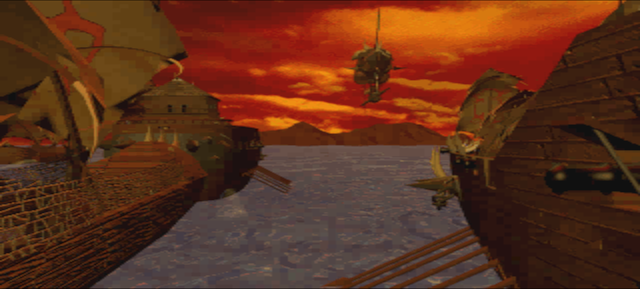
The actual main menu is still nice to look at. Its background is drawn by Chris Metzen, who also drew some of the manual illustrations. Though Metzen’s worldbuilding became the definitive foundation of the Warcraft setting, his art style didn’t stick.
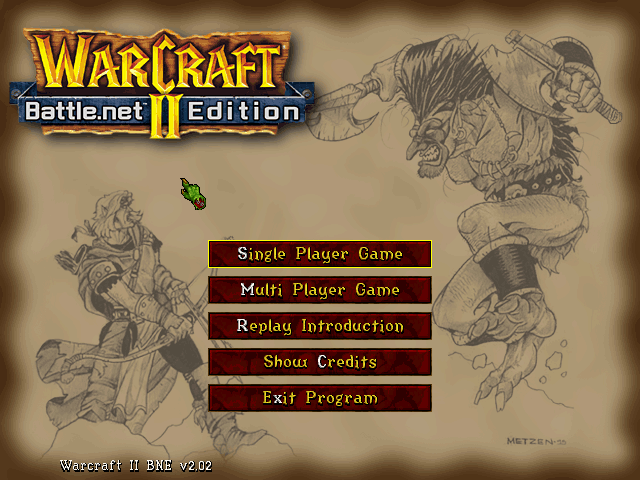
Just like Warcraft 1, this game features two mutually exclusive campaigns with incompatible endings. First, we’ll look at the orc one.
The Gameplay
First things first: the higher production values are evident. Instead of 320×200, this game runs at the resolution of 640×480, which allowed the artists to make the units and buildings more distinct, and the overall style more unique. It really shows that they made the battlefield as easy to quickly scan as possible, with unit appearances differentiated. I suspect this might have been part of the motivation for making the unit composition more multi-racial. They completely eliminated the “blob of green pixels” problem that I wrote about before.
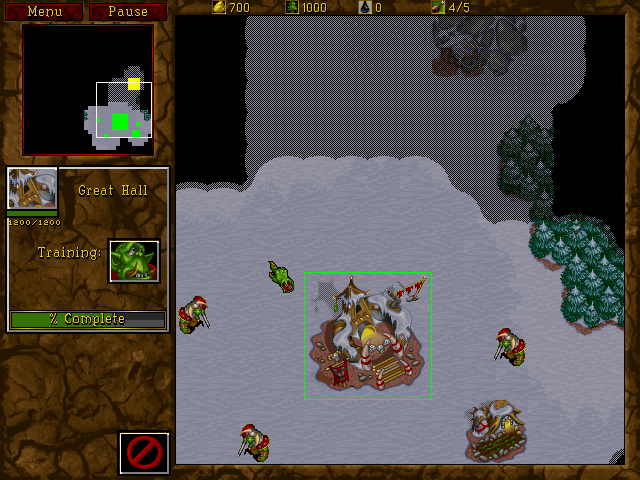
Awkward attempts at pixelated realism are gone, replaced with a more cartoony, fairy tale aesthetic. It’s still not the Warcraft aesthetic we know, though, especially the Horde buildings. Rather, it’s a style that came and went.
Unit voice lines are a lot more varied now. The missions themselves are more varied and no longer boil down to just “destroy all enemy bases” or “kill or rescue a specific unit with a limited army”.
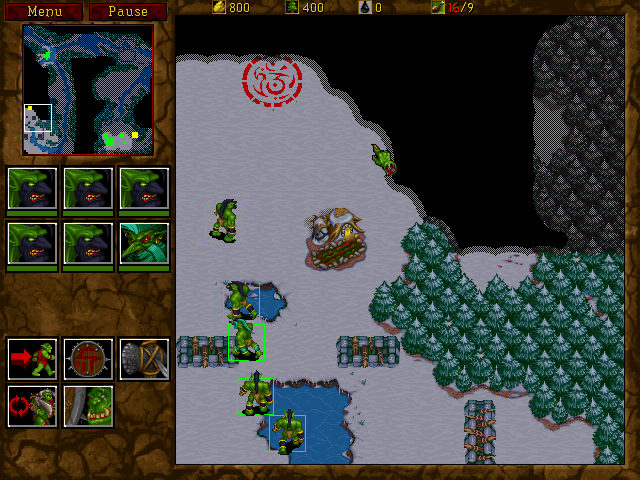
That red thing on the ground is a Circle of Power, and it’s always tied to a custom victory condition. Usually, you’re asked to escort a specific unit there (making it a replacement for the Hostage Rescue Zone from Warcraft 1), but sometimes, you may be asked to construct specific buildings near it. You can place a Circle of Power on a custom map (yes, there’s a map editor now!), but it does nothing; its functions on campaign missions are effectively hardcoded.
Controls have been much improved. Movement by right click is a thing now, as is attack-move. You can select by drawing a rectangle, move squads of 9 units, and assign hotkeys to squads. This allowed Blizzard to make the gameplay more dynamic and fast-paced.
The road mechanic is gone, never to return. Bases no longer resemble towns, but there is much greater freedom of placement for buildings as a result.
The unit roster is greatly expanded and is much more versatile than in Warcraft 1. Each faction now has two air units: a fast scouting flyer that cannot attack (Zeppelin/Flying Machine) and a powerhouse (Dragon/Gryphon Rider). But by far the most important change is…
Naval Warcraft
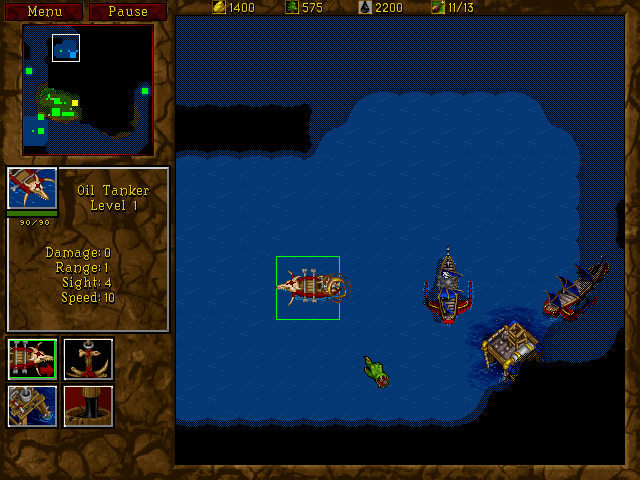
Warcraft 2 is the only Warcraft RTS game to feature a third resource: oil. Oil Tankers are the naval equivalent of peasants and peons: they construct the only building that’s built in the open sea, the Oil Platform, gather oil, and deliver it to the nearest Shipyard or Oil Refinery. There are other ship types as well: the light but fast Destroyer, the slow powerhouse Juggernaut/Battleship, and the normally-invisible Giant Turtle/Submarine.2 Finally, Transports can ferry your ground troops across the sea.
The addition of naval units gives Warcraft 2 a lot more strategic depth than Warcraft 1, but it also comes with problems. This is an early example of how Blizzard often gets excited with a new gameplay mechanic and goes overboard with it, putting it absolutely everywhere they can touch until everyone is tired of it.3
To wit: most of the orc campaign takes place on islands-type maps (there are only three missions that don’t, two of them being the very first two). You usually start on a different island than your opponent, so you have to bring your army to them on transport ships. And to construct just one transport ship, you have to:
- Ramp up your resource gathering, which means training more peons, building more farms so you can train your peons, and spread them between gold and lumber.
- Build a lumber mill, which is a prerequisite to the shipyard.
- Build a shipyard.
- Build an oil tanker to harvest oil, which is used by all other naval units.
- Find an oil patch and build an oil platform there.
- You will probably want to build some destroyers to secure your oil platform from enemy ships.
- Build a foundry to unlock transport ships.
- And then, then you will finally be able to build transport ships and actually attack the enemy base.
Oh wait, you probably want to build up your ground troops as well so you actually have an army to ferry. And you have to distribute your resources between ground units, naval units, and more peons.4 And defend yourself from your opponent making landfalls near your base. There is no magic button that transports your units in the field back to your base if you get attacked. Did I mention that you often start with a very undeveloped base, and sometimes you start with just peons and have to build a base from scratch? Have fun!
Finally, there’s still the problem with post-siege slogs. Most missions, like in Warcraft 1, task you with destroying all enemy buildings and units. However, it is now far more difficult than before, because of the fog of war and because the maps themselves are enormous. Many maps consist of relatively small islands separated by nothing but featureless water, and I feel like they made the fantasy of crossing boundless seas a little too authentic. While it seems to me (though I cannot verify this) that remaining enemy units are programmed to attack you after you destroy all their buildings, this certainly isn’t the case for worker units (peasants, peons, and oil tankers), which just flee from you and make the mop-up all the more tedious.
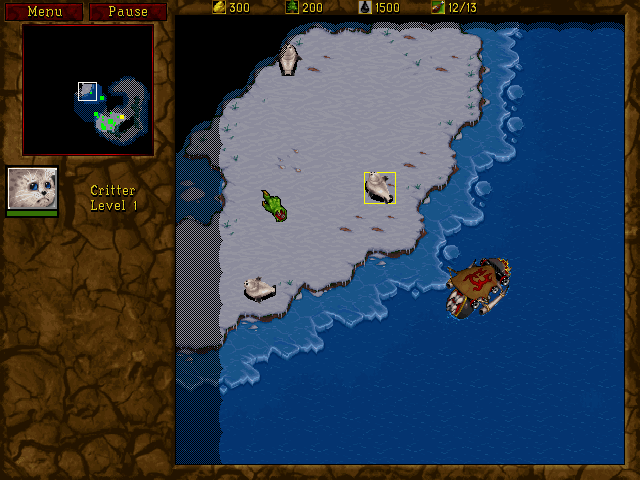
I may have been more negative here than the game deserves. I know that many people swear by Warcraft 2, especially competitive players (which I’m absolutely not, and I’m not at all a good source on gameplay strategy). This game is a lot more fun to play than Warcraft 1 and was a massive breakthrough for its time.
The Story
Once again, the story is pretty barebones, told exclusively in mission briefings with voiceover, and focuses mostly on conquering the land bit by bit. The 3D flyover map is gone, replaced by static maps at the beginning of each of the campaign’s four acts.
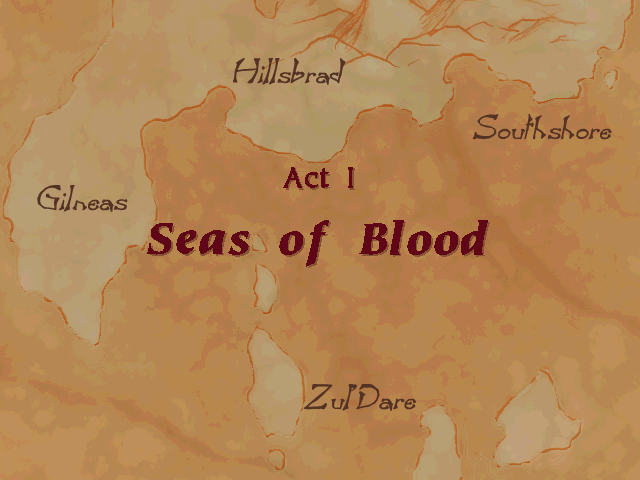
- You are preparing to assault Lordaeron’s southern shore. Orgrim Doomhammer, War Chief of the Orcish Hordes and ruler of the Blackrock clan, commands you to build four farms and a barracks.
- You rescue Zuljin and his trolls, held captive by humans and elves. They pledge themselves to the Horde.
-
With the aid of troll axethrowers and destroyer ships, you construct a shipyard and four oil platforms. For some reason, this map is the only one in either faction’s Act 1 to use the summer tileset, while all others, which lore-wise take place in the same region at about the same time, use the winter tileset. It seems the map maker didn’t get the memo.
There’s some clever design here. There are actually five oil patches on the map, but you only need to build four oil platforms. However, two of the patches are occupied by human oil platforms, so you’ll need to destroy at least one of them first.
- Finally, you transport your units across the channel and raze the human town of Hillsbrad.

-
You build a base at Dun Modr, a captured dwarven outpost Khaz Modan, and level the Stromgarde island citadel of Tol Barad.
I appreciate the consistency in colors here. Normally, you play as the Blackrock clan, whose color is red. However, here you’re fighting Stromgarde, who are also red, so in these missions you instead play as the Black Tooth Grin clan, which is black. This is purely cosmetic, as the tech tree is exactly the same.
As an aside, the appearance of the name “Tol Barad” in Warcraft 2 fascinated me ever since I read The Lord of the Rings as a child, as it’s another one of several examples of inexplicable Sindarin in the Warcraft setting.5 (Sindarin is the language that is called “Elvish” in the book itself.) We’ll see more of them later. Specifically, “Tol Barad” means “Isle of the Tower”, which is oddly appropriate. I wonder if the writer knew this or simply mashed together Tol Brandir and Barad-dûr.
- You escort the ogre-mage Cho’gall through the badlands of Khaz Modan so he can inspect the refinery at Grim Batol for… er… some reason. Weird choice of inspector, but all right. This is a short and sweet mission that gives you a limited army and features no base-building.
- “Cho’gall reports that the Khaz Modan Refineries are well maintained and fulfilling their quotas.” A rare sentence. With the preparations done, you launch a naval attack against Stromgarde. This is one of those missions where you not only start without a base, but you have to actually find a gold mine first.
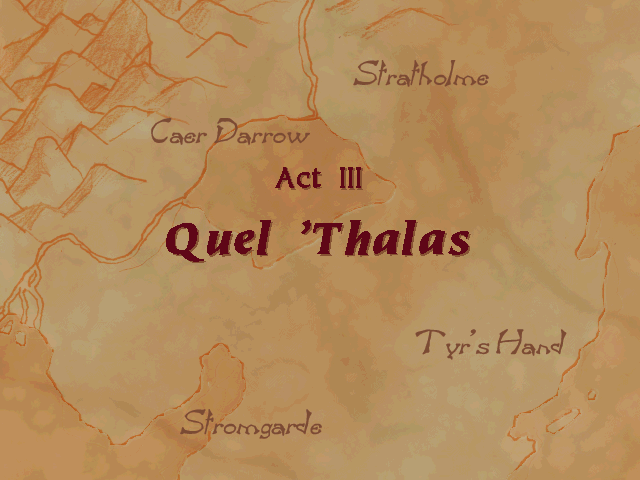
- You capture the Runestone at Caer Darrow on the southern border of Quel’thalas [sic], so Gul’dan can experiment with it.
- Through the Runestone, Gul’dan turned your ogres into ogre-magi. Now you’re tasked with building a fortress on an island at the mouth of Tyr’s Bay. This is a rare mission that contains a Circle of Power, but doesn’t ask you to escort any unit to it, instead using it as a trigger for specific buildings you’re asked to build.
-
You destroy Stratholme, “the chief source of Alliance Oil in the north”, and all its refineries and oil platforms.
Yes, the geography of this campaign act has pretty much been completely retconned. These first three missions are all supposed to be taking place at Darrowmere Lake, but Stratholme, Tyr’s Hand and the Quel’Thalas border are now nowhere near it, putting it mildly, and the first two are now landlocked.
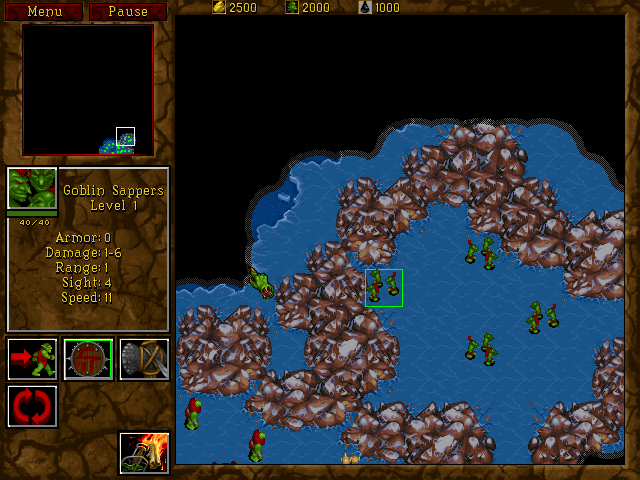
- Finally, Gul’dan has offered you his death knights for your final assault on Quel’thalas itself, which for some reason is southwest of your starting point on the map. Also, this map, like the rest of this act, uses the winter tileset. It’s not yet eternal spring in the elven lands.

- For the obligatory Civil Warcraft mission, you are to hunt the treacherous Stormreaver and Twilight’s Hammer clans, whom Gul’dan took with him to search for the Tomb of Sargeras, which he raised from the bottom of the sea. Gul’dan himself is a unique death knight-like unit surrounded by daemons, and to get to him, you need to break rocks in the middle of the island. That’s right: you kill Gul’dan here, not a daemon in the Tomb of Sargeras, as the preceding cinematic implied.
- You raze the Violet Citadel of Dalaran, which in this version is located on a cross-shaped island. Despite being a city of magic in lore, it starts with a single measley mage tower and no mage units, instead having a large garrison of knights and other regular human units.
- Finally, as the culmination of the campaign, you storm the capital city of Lordaeron across Lordamere Lake, fighting the forces of Lordaeron, Azeroth (Stormwind) and Kul Tiras at the same time.
And your reward is another cinematic that’s hilariously janky in hindsight.
The victory pyres burn high into the twilight skies covering the ruined capital of Lordaeron. Your success has led Orgrim Doomhammer - War Chief of the Orcish Hordes - to elevate you to the station of Warlord, thus giving you power and the command of your own clan. The Alliance has finally been crushed, with all those surviving being slain and cremated as is dictated by the rituals. At long last Azeroth and all of its lands belong to the thunderous force known to those foolish enough to stand in its way as the Horde!
That’s right. No sequel hook.
My Thoughts
This is the first Warcraft RTS campaign on my memory that actually feels like, well, a campaign, in the original military sense.
The geography of the northern continent was tailored to the story, and it shows. This is a proper military offensive on multiple fronts, with bases of operations, logistics, disruption of enemy resources, and clear progression that makes sense geographically.
No, this campaign isn’t remotely realistic by the standards of serious military fiction, but for a broad-strokes fantasy game setting like Warcraft, it’s pretty well-considered. The downside is that there’s almost no focus on the characters, even compared to Warcraft 1. It’s all army maneuvers and sieges with you as a nameless commander.6
Unfortunately, both Tides of Darkness campaigns are among some of the most heavily retconned content from the Warcraft RTS games, and their concept only survives in very broad strokes. For one, the importance of naval battles is de-emphasized, mentions of oil are practically excised, and the entire war is considerably shortened in later lore.
Finally, I find this strange that a very prominent Chekhov’s Gun from the manual didn’t fire here. The manual said that Rend and Maim, leaders of the Black Tooth Grin clan, might betray Doomhammer when they sense an opportunity, but this never happens. In fact, in some missions, you play as the Black Tooth Grin clan, and the question of their loyalty is never raised. The only time you fight other orcs is the Tomb of Sargeras mission, where you go after Gul’dan. I wonder if this is a remnant of an early story idea that got axed during development.
We’ll look at the other side of the story next time, with the human campaign.
-
Ironforge, Storm Peaks, Highmountain, and Azure Span, to name a few. ↩
-
They are invisible and can only be detected by flyers, towers, and their opposite unit, encouraging rock/paper/scissors gameplay. ↩
-
Two examples from WoW would be vehicles and phasing, both of which debuted in Wrath of the Lich King, but Cataclysm overused them to the point of fatigue. ↩
-
Peons and peasants in this game gather gold in bundles of 100 and lumber in bundles of 125, but take a relatively long time to harvest each. A worker cycling between a gold mine and the town hall/great hall will disappear inside each building for a short while. However, you can send any number of workers to the same gold mine, limited only by your food cap. Warcraft 3 will later change all this. ↩
-
Technically, the first example is the name Anduin “long river”, but this one is simply borrowed from LOTR wholesale rather than constructed anew. Later examples include Lithduin Reef (lithduin = “ash river”) and Tol Dagor (“isle of battle”). ↩
-
Apparently, Ask CDev and Chronicle 3 confirm your character to be none other than Varok Saurfang, but the issue is muddled and at any rate doesn’t have any story importance going forward. ↩
Leave a Comment